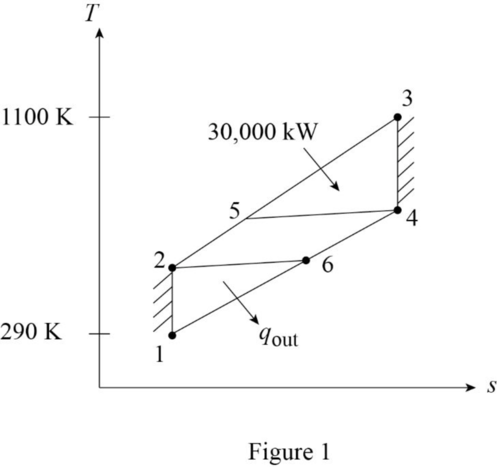
a)
The power delivered by the plant assuming constant specific heats for air.
a)
Explanation of Solution
Given:
Temperature of the air at the compressor inlet
Pressure of the air at the compressor inlet
Temperature of the air at the turbine inlet
Pressure of the air at the turbine inlet
Rate of heat transferred to air
Effectiveness for the regenerator
Calculation:
Draw the

Refer Table A-2, “Ideal-gas specific heats of various common gases”, obtain the properties of the nitrogen.
Calculate the pressure ratio
Calculate the temperature at state 2
Calculate the temperature at state 4
For 100% effectiveness of the regenerator, the temperatures at states 5 and 4 are equal and the temperatures at states 6 and 2 are equal.
Calculate the thermal efficiency of the cycle
Calculate the power developed by the plant
Thus, the power delivered by the plant assuming constant specific heats for air is
b)
The power delivered by the plant accounting for the variation of specific heats with temperature.
b)
Explanation of Solution
Calculation:
Refer table A-21, “Ideal gas properties of the air”, obtain the enthalpy and relative pressure of air at the temperature of
Calculate the relative pressure at state 2
Refer table A-21, “Ideal gas properties of the air”, obtain the enthalpy of air at the relative pressure of
Refer table A-21, “Ideal gas properties of the air”, obtain the enthalpy and relative pressure of air at the temperature of
Calculate the relative pressure at state 4
Refer table A-21, “Ideal gas properties of the air”, obtain the enthalpy of air at the relative pressure of
For 100% effectiveness of the regenerator, the enthalpies at states 5 and 4 are equal and enthalpies at states 6 and 2 are equal.
Calculate the thermal efficiency of the cycle
Calculate the power developed by the plant
Thus, the power delivered by the plant accounting for the variation of specific heats with temperature is
Want to see more full solutions like this?
Chapter 9 Solutions
FUND. OF THERMAL-FLUID SCIENCES CONNECT
 Elements Of ElectromagneticsMechanical EngineeringISBN:9780190698614Author:Sadiku, Matthew N. O.Publisher:Oxford University Press
Elements Of ElectromagneticsMechanical EngineeringISBN:9780190698614Author:Sadiku, Matthew N. O.Publisher:Oxford University Press Mechanics of Materials (10th Edition)Mechanical EngineeringISBN:9780134319650Author:Russell C. HibbelerPublisher:PEARSON
Mechanics of Materials (10th Edition)Mechanical EngineeringISBN:9780134319650Author:Russell C. HibbelerPublisher:PEARSON Thermodynamics: An Engineering ApproachMechanical EngineeringISBN:9781259822674Author:Yunus A. Cengel Dr., Michael A. BolesPublisher:McGraw-Hill Education
Thermodynamics: An Engineering ApproachMechanical EngineeringISBN:9781259822674Author:Yunus A. Cengel Dr., Michael A. BolesPublisher:McGraw-Hill Education Control Systems EngineeringMechanical EngineeringISBN:9781118170519Author:Norman S. NisePublisher:WILEY
Control Systems EngineeringMechanical EngineeringISBN:9781118170519Author:Norman S. NisePublisher:WILEY Mechanics of Materials (MindTap Course List)Mechanical EngineeringISBN:9781337093347Author:Barry J. Goodno, James M. GerePublisher:Cengage Learning
Mechanics of Materials (MindTap Course List)Mechanical EngineeringISBN:9781337093347Author:Barry J. Goodno, James M. GerePublisher:Cengage Learning Engineering Mechanics: StaticsMechanical EngineeringISBN:9781118807330Author:James L. Meriam, L. G. Kraige, J. N. BoltonPublisher:WILEY
Engineering Mechanics: StaticsMechanical EngineeringISBN:9781118807330Author:James L. Meriam, L. G. Kraige, J. N. BoltonPublisher:WILEY





